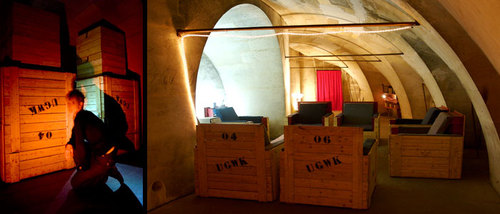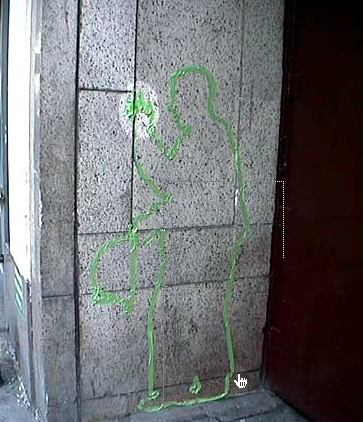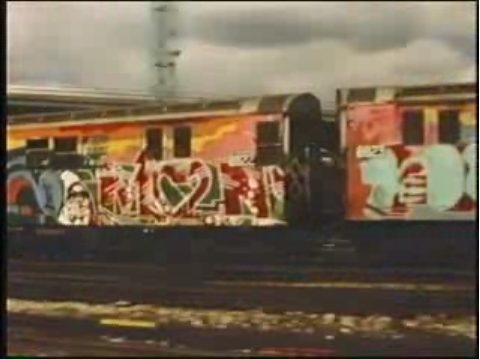
Wow. I can’t believe this was shot in 1977. Stations of the Elevated, Manfred Kirchheimer’s remarkable documentary–is art documentary a genre?–of New York City’s graffiti-saturated trains and their environs is a total throwback feast. The film puts graffiti into the larger context, contrasting the tagged-up trains with the visual cacophony of officially sanctioned paintings of the day: billboards. For 45 engrossing minutes, the lost texture of mid-70’s New York rolls by, accompanied by a Charles Mingus soundtrack.
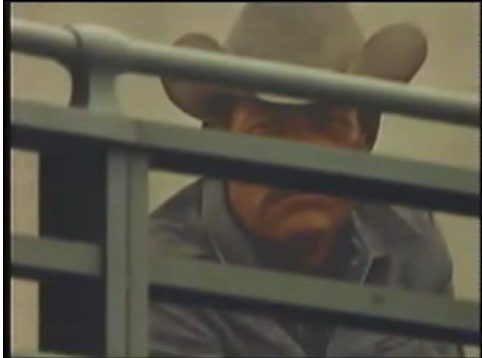
A Washington Heights native who might’ve been expected to criticize the poor, non-white graf artists who moved into the neighborhood, Kirchheimer instead provides a sophisticated and persuasively sympathetic view of a visual language that challenged the corporate marketing machinery on its own terms: painting.

It’s ridiculous to say it out loud, but I’d forgotten that they used to paint billboards. It’s incredible how familiar yet utterly alien the advertising landscape of Stations is to 2007 eyes. Those billboards are stunning, as if the whole of the Bronx were painted by Mel Ramos.
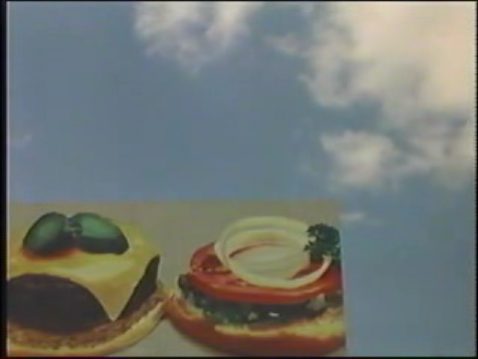
As recently as 30 years ago, painting was not [just?] a twee, aesthete’s diversion, cloistered in the museum; it was a mass medium of daily communication. When graffiti artists took up their paint, it was the default medium of expression, not only in galleries, but right there along the tracks.
Stations of the Elevated was screened at the 1981 NY Film Festival, and it’s been released before on VHS. According to a letter the filmmaker wrote to the NY Times last fall, Stations and a follow-up doc, Spray Masters were supposed to be released on DVD in the spring of 2007. So far, though, there’s nothing online.
The entire film is on YouTube at the moment, chopped up into the Tube’s mandatory <10 minute segments. It's a great taste, but it'd be so worth it to get a clean transfer on DVD.
Stations of the Elevated, in 5 parts [youtube, images, too]
Category: art
On The Table: Buckminster Fuller Chandelier
Buckminster Fuller wha?
It was the photo caption in the photo spread of the Foreign Office Architects country house project in the November 2007 World of Interiors on the coffee table. I snapped a quick phonecam photo, thinking I’d look it up later and find some random product Fuller had licensed, and then I’d pick one up on eBay some day, but no. Oh, no.
Now I have to track down this one, the only one, a wedding present of some renown.

From Maggs, the rare books and art dealer who apparently sold the Margaret/Snowdon Fuller Chandelier some time in the Internet era [I’m guessing around 2004] to its current owner [an art dealer, so there’s hope, at least]:
Designed by Buckminster Fuller, and made by James & Gill Meller as a wedding present for Princess Margaret and Lord Snowdon.
A basketweave geodesic sphere, of perspex (aka lucite) prisms wired together with steel fishing line, served with crimps and electrical terminals, the crimps threaded into cut out venturi.
89 cm in diameter, just over ten kilograms in weight.
Attractive and practical [!?], this is a unique three-dimensional souvenir of the great maverick philosopher-inventor Fuller and a remarkable manifestation of a period when Britain, against the odds, embraced and integrated the ideas of this most awkward and inspirational member of the American avant-garde into a new school of radical architecture…
Snowdon, it will be remembered–or in my case, learned–collaborated with Fuller supporter Cedric Price and the engineer Frank Newby on the tensile architecture of the London Zoo aviary. Architect James Meller built the thing with prisms “from The Perspex Shop” and “eighty pound plastic-coated trace wire) and crimps from Farlows in St. James’.”
Geometrically speaking the sphere is a truncation of a truncated icosahedron, a form which results in a polyhedron with 12 pentagons, 20 hexagons, 60 triangles, 90 vertices, and 180 edges. It works tremendously well as a chandelier, as the Perspex components function as refracting prisms and produce subtle rainbow coloured patterns. It is currently suspended on a simple rope harness, with no light source supplied.
Or at least it was. Now it’s sitting on a table in what used to be the cheesemaker’s living room. If anyone has a fuller [heh] image of the chandelier, I’d love to see it. And if you have a royal, hand-wired, geodesic chandelier you’ve grown weary of, do call.
A ? THE! A Geodesic Chandelier [maggs.com]
The Purpose Of Art Is To Make More Art
As the art market began heating up and becoming much more fashionable a few years ago, I started to wonder what the effect of all this demand would be on the art that was produced. Surely, 95-plus percent of the objects and paintings would not ever be made, projects wouldn’t be conceived, much less realized, in the absence of an insatiable-seeming market.
Sure, like Morris Louis and Clyfford Still before them, painters and drawers might produce work at a grueling pace, then roll them up and stuff them in a barn–or their parents’ suburban attic crawlspaces or whatever the equivalent is today. Conceptualists might follow Dan Flavin’s footsteps and design all their work and file it away for execution in the event anyone ever actually bought it. And that might be happening.
But there are giant works with cost- and labor-intensive production requirements; public commissions for new cultural capitals; hundreds of linear miles of art fair booth walls to be filled; follow-on rounds of loft and country home renovations proceeding apace. The art market needs product.
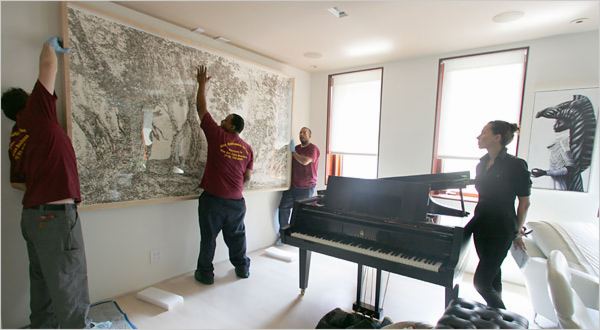
That photo a few weeks ago in the Times of yet another near-life-sized inky tree by Ugo Rondinone being art handled into place was a clincher; it accompanied an article about bankers and hedge fund managers compelled to quit their dayjobs in order to manage their serial seven- and eight-figure remodeling projects. Can someone please explain why I should care about art whose most salient feature is its ability to anchor a handrubbed plaster wall in a townhouse that never gets lived in?
I was pleasantly surprised to find that Richard Prince is a source of wisdom on this question of art world demand. Like the Dalai Lama, my problem isn’t with the man himself, but with his Richard Geres. And at this Conde Nast-LVMH-Guggenheim-Phillips dePury moment, the man has way too many Richard Geres.
Yet in the 4-part video follow-around on VBS.tv, Prince is very convincing when he says he doesn’t give a damn what anyone thinks about his work, and the good thing about people wanting to buy it is that it helps him make more work. Whether the world is a better place with a dozen more nurse paintings in it actually feels beside the point, even if it’s not. To see a nurse painting propped nonchalantly in the background, and to know that Prince could make another tomorrow–or not–imbues these now-precious objects with an unshakable arbitrariness, entirely subject to the artist’s prerogative. Which is entirely at odds with the disintermediating artifice of the primary dealer and her waitlists–and with the even more intense simulation of rarity of the auction block. And still we come.
It makes me think, too, of Olafur Eliasson’s work, but for entirely different reasons. As the scale, complexity and spectacle of Olafur’s work has expanded, most dramatically since his 2004 Turbine Hall installation, it’s sometimes seemed that literally any idea or iteration or object that crossed through his head could be realized. The question became, “should it?” With no apparent physical, production, or economic constraint, does the artistic process get inverted and lose the refinement, iteration, editing, and winnowing steps that presumably results in the strongest work?
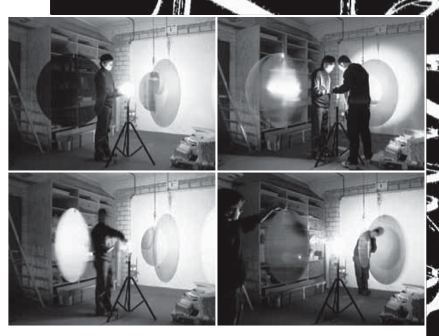
Is any/every possible configuration of hanging prism, spotlight, and rotating motor equally “good”? Do we weigh the significance of each element and decision differently if we know it’s the only one or if we know that every other variation exists somewhere, too, in a European private collection? Or is “uniqueness” as misplaced an object of our artistic rapture and devotion as “authorship”?
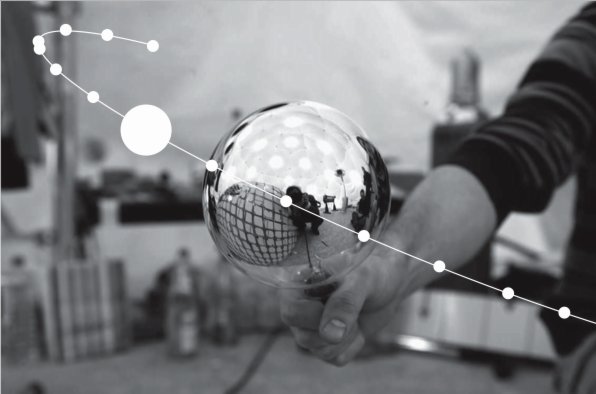
MIT art historian Caroline A. Jones pulled back the curtain on Olafur’s prodigious studio practice in an article for last month’s special Production issue of Artforum. Somehow threading the needle between the art world’s post-object conceptualism and the art market’s dazzling luxury consumerism, the studio has made experimentation and research its main “product”; which makes the saleable works something of a “by-product,” by-products which fund the ongoing idea production of the studio.
It feels like an imperative transposition for an artist to make, especially when cognizance of the demand for one’s work can create an existial crisis. I mean, I buy the stuff, and it often feels superficial, decorative, and money-flaunty; I can only imagine how it can feel to be making it.
And just as the mechanical means–lights, tripods, scrims, scaffolds, motors–used to create the natural phenomena have always been open, discoverable parts of each work, now Olafur’s studio is making its own process and mechanisms known.
Take Your Time is the Studio’s magazine. Vol. 1, Small spatial experiments, goes behind into the scenes, documenting several recent high-profile projects, including the Serpentine Pavilion, BMW’s Art Car, the Music Hall in Reykjavik, Pinault’s Venetian Christmas decorations, and some that could actually be considered small.
I don’t know if it’s coming to a Barnes & Noble near you, but I imagine it’ll be at the galleries. And it’s available as a nice, fat PDF file from the Studio website.
Take Your Time, Vol. 1, Small spatial experiments [olafureliasson.net]
Sata-Koons
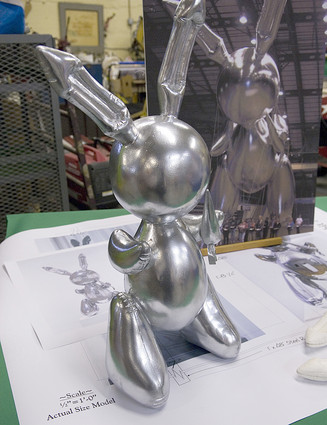
Alright, the clock is ticking, only hours to go until Jeff Koons’ largest work to date, a 53-foot high balloon based on his 1986 sculpture, Rabbit, bobs down the west side in Macy’s parade. It was made using a new material intended to replicate the original sculpture’s mirror-like stainless steel surface. Said Koons in a Macy’s press release, “I think one of the reasons why Rabbit is an iconic work, a popular piece, is because it’s so reflective. It reflects the needs of culture and society and can represent so many different things to the viewer.”
Courant’s critic wonders what I wondered, which is what other art balloons have been in Macy’s “Blue Sky Gallery” series? I can’t find any previous artists mentioned.
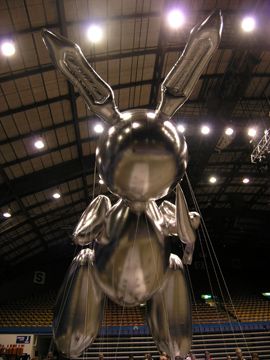
Anyway, Gallery or not, the Satelloon would not be able to appear in Macy’s parade; Manhattan’s avenues were laid out to be 100 feet wide, the same as the Satelloon itself. What with the streetlights and trees and whatnot, it just wouldn’t fit.
Still, I hope it’ll make a nice, intimate venue for Koons’s modestly scaled work.
Money quote: “A giant silvery rabbit that looks like a massive bunny-shaped UFO? [courant, also top image]
Rabbit inflation test shot via fashionweekdaily [fashionweekdaily.com]
Previously: The Satelloons of Project Echo
If I Were A Sculptor, But Then Again…
Architecture As Art History
I guess when you’re a hammer, everything looks like MoMA. It’s “Subverting The Dominant Installation” Week at Modern Art Notes, where Tyler is taking inordinate pleasure in shadow boxing with an opponent who retired long ago: Alfred Barr’s rickety, linear [sic] march of Modern Art history as experienced in the gallery walk at MoMA. As Tyler condemns it, Barr/Rubin/MoMA put Postwar New York at the center of Art, and annointed Jackson Pollock to lead everyone else to abstraction’s Promised Land. [But wait, maybe I can solve this problem before I even get started complaining. What if Clyfford Still is Moses, then Pollock could be Joshua!]
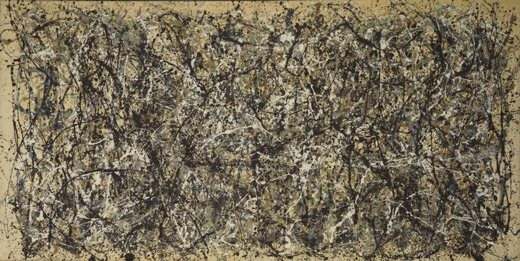
Tyler’s exercise interesting and–in this case–harmless, but it’s also artificial almost to the point of irrelevance. Set aside the discussion of just how much “dominance” MoMA’s installation has or should be granted in the polyvalent art world of 2007 [I’m a longtime MoMA supporter and fundraiser for whom the Museum functioned as an ersatz graduate school of modernism, which may be why I feel so strongly that the art world should have outgrown the self-inflicted notion of centralized canonizing authorities by now. And except for when we play these kinds of curatorial parlor games, I think most people have.]
The sequence of galleries on MoMA’s fifth floor forms the basis of MAN’s “dominant installation” theory:
MoMA’s installation, which is in part an accident of architecture and in part not (someone put all those Pollocks together and banished everyone else), encourages us to see Pollock as the titan, the artist who, along with Picasso and Matisse gets a MoMA gallery to himself. The not-so-subtle suggestion is that everything else in American hero painting stems from Pollock, that it all comes after him, that no one else is worthy of sharing his space. As proof, at MoMA those other artists all are after Pollock, not with him.
OK, but that’s not how it happened…
Tyler has been spending the last few days expanding on that by showing what other artists’ momentous works from 1950 which were created alongside [i.e., concurrent with] Pollock’s, but which MoMA baldly puts in other rooms.
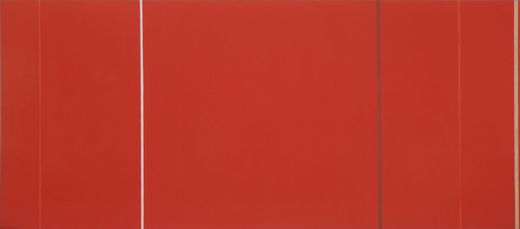
Rather than simply point out what seems to me an inherent flaw in Tyler’s premise–unless you’re talking about Jerry Saltz’s curatorial fantasy of lining up all the works in the collection by the date they left the studio, the march through architecture does not only ever equal the march of time; in fact, since its conception before the MoMA2000 era, the Taniguchi building & installation has been intended to alleviate, if not obviate, the outdated, pedantic, this-begets-that, historicist puzzle-solving–I’ll counter with a lost installation example from the, uh, Bad Old MoMA that I think unproves Tyler’s point today about Barnett Newman’s massive painting, Vir Heroicus Sublimis. It also happens to be one of the most sublime juxtapositions of art I’ve ever seen.
In the old MoMA’s 4th floor galleries, Pollock did have a gallery to himself, but it wasn’t the apotheosis of anything. The Pollock room was off to the right, with One: Number 31, 1950 on the main wall, while History marched on to the left; to the architectural determinists in the audience, Pollock was a dead end.
Only, of course, it wasn’t. When you turned around and looked through a couple of enfilade doorways, there was Newman’s Vir Heroicus Sublimis facing you–and the Pollock to your back. I forget what was in those galleries–late Matisse, maybe? who could care?–because these turning back and forth between these two giant paintings made the same year was too engrossing. Newman wasn’t taking the “next-steps of American high-abex,” he was making his own powerful arguments longside/against/in response to [sic] Pollock’s painterly actionism.
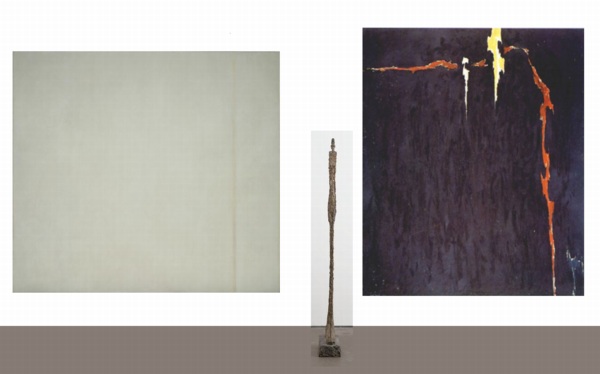
When you got into the room with the Newman, though, things really heated up. On the right/west wall [recreated above in Photoshop] hung another 1950 Newman, The Voice [above, l], and next to it was a Clyfford Still. If the timeline were the arbiter, it’d be 1951-T No. 3, a work whose reused abstract composition Still dubbed a “replica.” [Let’s see Pollock try that.] But I’m almost certain it was the much earlier–d’oh, and thus asynchronous–1944-N No. 2 [above, r].
The greatest touch, though, was the most seemingly controversial: the insertion of a European sculpture, Giacometti’s Standing Woman, from 1948, which functioned visually as, of all things, a humanoid zip. I’ve never looked in the literature, but I can’t imagine how this time- and continent-and style-hopping installation could be considered anything but heresy to those who insist that someone’s insisting on brightline, AbEx and The American Way art history. And yet, there it was, right there in the heart of MoMA. Did anyone complain? Or did it just look too awesome? Or was there always more to the Newman et al. story, like what artists themselves thought, even at MoMA? from Vir Heroicus Sublimus‘ page at MoMa.org:
Newman admired Alberto Giacometti’s bone-thin sculptures of the human figure, and his stripes, or “zips,” as he called them, may be seen as symbolizing figures against a void.
Taniguchi’s MoMA makes some attempt to break up the classical, enfilade march of galleries, but it’s obviously not perfect. The classical vista and the faceoff have been replaced by the turn and the oblique glimpse as the museum’s spatial and viewing modes. When they hung the new galleries, MoMA’s curators programmed in these pans and the distant glimpses of resonant works afforded by all the new, non-dogmatic doorways.
But even if you don’t buy into this attempt at mixing it up, can anyone realistically expect that MoMA would destroy itself as a historically continuous institution “merely” to accommodate the fifth renovation of its space? Should the ghost of a building known as the Dorset Hotel hold sway over Art History, its circumstances defining the shapes and flow of the galleries much as the one-by-one acquisition of the townhouses that once occupied the original 53rd Street site did? MoMA’s linearity, both spatial and intellectual, is a historical phenomenon as driven as much by these palimpsest floorplans as by Barr and Rubin’s schematic diagrams.
And this received wisdom is actually influenced as much by the trustees and collectors and tastes of the era, too; remember, despite several attempts by dealer/trustee Sidney Janis to place it there, Barr and MoMA refused Pollock’s Autumn Rhythm, which finally ended up at the Met. And it wasn’t until 1967, well into the Rubin era, that they could even manage to acquire One, No. 31, 1950 at all. If people actually knew more about the messy, cantankerous, and wrangling processes of how that “dominant installation” came to be, they may not be so inclined to let it dominate them.
And if they’re going to be strict architectural literalists in their interpretation of a the symbolism of a museum installation, they might as well look back to the Old Testament MoMA as well. And they might as well note that Newman’s painting currently hangs in the same spot as Picasso’s Les Demoiselles d’Avignon on the floor below. Maybe Newman is Moses and Pollock is just Aaron. Or Pollock’s John the Baptist, and Newman’s–well, I’m sure Newman would’ve been pleased with the spot he got.
Olafur’s Home Movies
Hello, Olafur Eliasson’s studio has a YouTube channel. A couple of months ago, right before the show opened at SFMOMA, he/they posted three videos that show various behind-the-scenes activities from your mobile expectations, the BMW Art Car project. Actually, part 1 has several shots of other works and studio activities, too. [Hi, Einar!]
They’re rather casually edited together, with no apparent arc and no narration, but they’re an interesting glimpse into Olafur’s studio process, which has expanded rather significantly in the years since I last visited. The videos are a nice complement to the Artforum article on the same topic, minus the elaborate contextualizing discourse, of course.
1/3 Studies for your mobile expectations – bmw h2r project
2/3 Studies for your mobile expectations – bmw h2r project
3/3 Studies for your mobile expectations – bmw h2r project
http://youtube.com/user/olafureliasson [youtube]
Cabinet’s Got Huge Balls
The Joshua Foer photo timeline, “A Minor History of Giant Spheres,” that got me all hopped up on Satelloons, is now online. It’s in the latest issue of Cabinet Magazine.
And while you should always buy or subscribe to Cabinet, the photos online are, on average, much bigger. The curse of the printed timeline format, I guess. [via kottke]
Previously: I will someday install a Satelloon in Grand Central Station, the Pantheon, and/or the Piazza San Marco.
“the most beautiful object ever to be put into space”
JMW Turner Overdrive
Time has a great review of the big JMW Turner exhibition–at the Museum of Modern Art in 1966.
The Washington Post, meanwhile, has an incomprehensible ramble about the bigger Turner exhibition at the National Gallery. Does Turner’s 40+ year-old position as an ur-Impressionist, ur-modernist still hold up? Who knows?
Landscapist in Light [time.com]
Turner, In Full Light [washingtonpost.com]
Come To The Drawing Center Curator Slam, Fri. Oct. 26
The Drawing Center has invited me to participate in a “Curator Slam” this Friday to celebrate the launch of their new Online Viewing Program. One of the Center’s greatest strengths has been its slide registry, which enabled artists who hadn’t shown in New York before to get their work in front of collectors, curators, dealers, critics, and the public.
Now the Viewing Program is available online, and offers a variety of search techniques–by medium, artist location, keyword, date, and artists’ text–to dig into the registry.
The Curator Slam will be–I’m told–a live, real-time curating/surfing event, where several of us simultaneously search the registry in front of the crowd, in order to put together a virtual exhibit of works on a given theme [to be provided that night, possibly via a fancy envelope or a fishbowl full of paper scraps.]
So far, I’ve played around with the Registry a bit, trying to see what kinds of results various searches produce. I can already feel that the “exhibit” produced will be as much about the process and the search tool as about the work or the artists. Reviewing work from gridded thumbnails inevitably impacts how and what you see; intimate subtleties are lost, while bold or easily read gestures and compositions are, well, easily read. Likewise, the artist’s statement and her very words, in fact, take on a more prominent role than they ever would in a gallery. It’s literally a filter by which the registry audience reaches the work. [On the other hand, I can’t imagine a single reason why the artist’s hometown would be relevant for searching/discovering his work. Though there are plenty of non-art reasons I can think of…]
The slam is free, and if you’re in town and easily amused, I would love to have a sympathetic face or two in the crowd–or at least an articulate heckler. It starts at 6:30, which gives you plenty of time to get in and out of Lucky Strike afterwards, and on with the rest of your evening.
Viewing Program Curator Slam, Friday, October 26, 6:30 PM, The Drawing Center, 35 Wooster St [drawingcenter.org]
The Drawing Center Viewing Program
Related: The Drawing Center’s 4th annual benefit auction is Nov. 7th. Check out the donated works.
It’s A Small Warhol’s World
I’m still looking around for anyone who gave an account of yesterday’s discussion of Warhol films at the American Museum of the Moving Image. Warhol Film Project director Callie Angell and film critic Amy Taubin were supposed to “discuss the artistic significance of Warhol’s films, the social and cultural milieu surrounding their production, and the history of their reception and their restoration.”
If you see something, please say something.

still from Inner and Outer Space, 1965
And as for the AMMI’s ongoing Warhol’s World film screening series, you should definitely see something. There are several reels of Screen Tests being shown. On Nov. 3rd, Saturday afternoon, a new print of Outer and Inner Space, the innovative double image, video-on-film portrait of Edie Sedgwick is screening. After that is a new print of Chelsea Girls. And the next week, Nov. 11th, is a new print of Lonesome Cowboys, which stars–among other people–Allen Midgette, the actor who pretended to be Andy during a 1967 speaking tour of western university campuses.
Warhol’s World – Screenings & Events, through Nov. 11th [movingimage.us]
Previously:
Have you seen me? Warhol’s lost videos
The Fake Warhol Lectures
Crate & Burial: UnterGunther’s Pantheon Workshop
It looks like the RISD Mall Dwellers have some stiff, French competition. Via UX frontman and UnterGunther spokesman Lazar Kunstmann comes this most excellent photo of the crates the guerilla restorers used to camouflage their workshop in the Pantheon, the mausoleum of the stars in Paris.
I would totally buy one of these–or two, really, since you’d want a matching pair–if they were exhibited and made available, say, as an art edition. And how cool would it be to have a little mantle-sized replica of the 19th-century clock movement the group repaired while hiding behind those crates for a year? Though I really do like the idea of urban exploring for fun and country, not fun and profit. Still, a guy can dream. [thanks, Lazar!]
Previously: the full UnterGunther Pantheon story, plus more urban exploration
UnterGunther: French Urban Explorers Sneak Into Pantheon For A Year, Repair 150-yo Clock
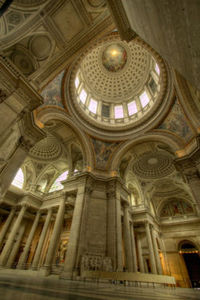

l: Pantheon r: Pantheon w/Ernesto Neto’s 2006 installation, Leviathan Thot
Wow, worlds collide, I feel like I’m in an Umberto Eco novel. At nights over the course of a year, a group of urban explorers in Paris who call themselves UnterGunther slipped into the Pantheon, the national mausoleum for French giants from Voltaire to Hugo to Marie Curie, and the site of Foucault’s original pendulum experiment. [yikes! I am!]
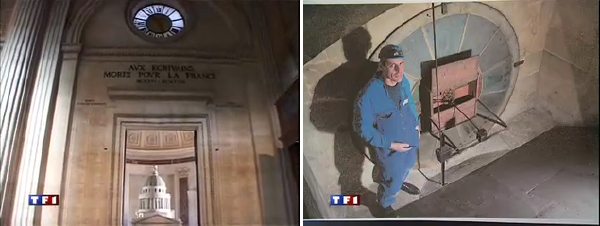
Once inside, they hid behind a wall of fake crates, and set to work restoring the movement of a massive clock, not working since the 1960’s, which they say had been neglected and left to rust into oblivion by the French government. The group enlisted a professional clockmaker, Jean-Baptiste Viot, to help on the project, which required fabricating several parts from scratch.
On October 10 2006, they presented the restored clock to Bernard Jeannot, curator of the Pantheon, who was expressed his profound thanks on behalf of a grateful nation. HAHA, kidding. He was horrified and launched a criminal investigation into the repair of the clock.
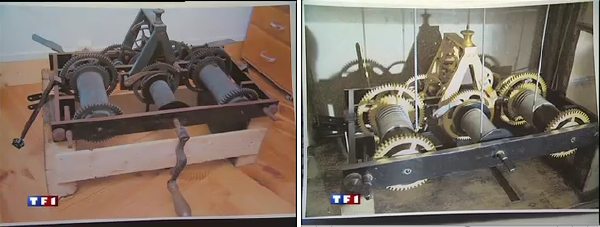
UnterGunther’s stated motives for these clandestine restorations–besides restoring things, of course–is to highlight “the incapacity of the French National Heritage administration, Monum, to preserve the heritage it is in charge of.” It’s a message that takes on unfortunate resonance with reports that drunken revelers recently broke into the Musee d’Orsay and punched a hole in a Monet–and then escaped unmolested by museum guards or police.
In an interview last month with the Times of London, who should turn up as the spokesman for UnterGunther’s urban explorer network, l’UX, but that underground cinema guru himself, Lazar Kunstmann. Fascinating and disturbing and invigorating stuff.
Unter Gunther’s report, english [urban-resources.net]
UnterGunther’s home page, with media coverage, in french [ugwk.eu, images above via the TF1 news story, 19Jul07]
Underground ‘terrorists’ with a mission to save city’s neglected heritage [timesonline.co.uk]
Related: Meanwhile, Americans sneak into malls and have parties for a year
Previously, Oct. 10, 2004 [!]: Exclusive: the greg.org interview with Lazar Kunstmann & La Mexicaine de Perforation
Les Arenes de Chaillot subterranean cinematheque’s complete programme guide
If I Were A Sculptor, But Then Again…

Yes, I do have a ton of other things I should be doing, but I can’t seem to get Project Echo out of my head. I really want to see this, 100+ foot spherical satellite balloon, “the most beautiful object ever to be put into space,” exhibited on earth. But where?
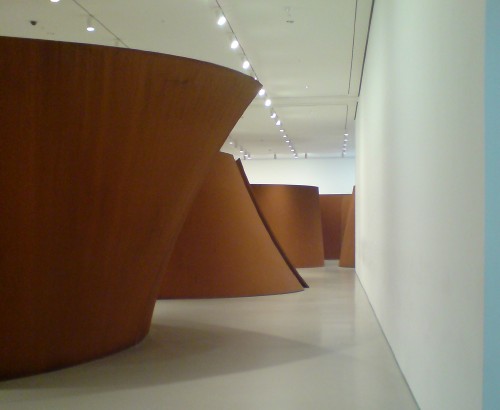
When MoMA was designing its new building, a lot of emphasis was placed on the contemporary artistic parameters that informed the structure. The gallery ceiling heights, the open expanses, the floorplate’s loadbearing capacity, even the elevators, everything was designed to accommodate the massive scale of the important art of our time: Richard Serra’s massive cor-ten steel sculptures.
And they did, beautifully, until just a few days ago.
But is there anything more anti-Serra, though, than a balloon? Made of Mylar, and weighing a mere 100 pounds? And yet at 100 feet in diameter, a balloon of such scale and volume, of such spatially overwhelming presence, it dwarfs almost every sculpture Serra has ever made?
The original Echo I was launched into space, but it was explicitly designed to be seen from earth. It was an exhibition on a global scale, seen by tens, maybe hundreds, of millions of people over eight years. People from the Boy Scouts to the king of Afghanistan organized watching parties. Conductors stopped mid-outdoor concert when Echo passed overhead.

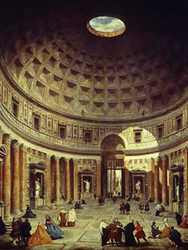
L: Hayden Planetarium = 87-ft diam. R: Pantheon = 142-ft. HEY!
What would an Echo satellite do to the art space it would be exhibited in? Are there even museums or galleries who could handle it? Or is the physical plant of the art world still organizing around the suddenly smallish-feeling sculptures of, say, Richard Serra?

Echo satelloons were first seen–or shown, isn’t that why there’s a giant NASA banner draped across it?–in a 177-foot high Air Force blimp hangar in North Carolina. There are plenty of non-art spaces where an Echo could be exhibited, but that misses the whole point.
What art spaces in the world are able to physically accommodate an 10-story high Echo? A gallery or museum would need unencumbered, enclosed exhibition space of at least 120 feet in every dimension:
Suddenly all these atriums and rotundas you think are just grossly oversized turn out to be too small. I guess the art world’s space limitations will be the constraining parameter for my Project Echo exhibition.
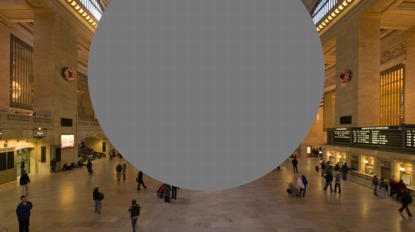
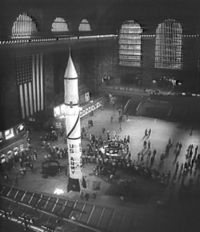
Maybe the only thing to do is to show it in a non-art-programmed space after all. Grand Central Station’s concourse is 160 feet wide and 125 feet high in the center. And as a bonus, a US Army Redstone rocket was exhibited there in mid-1957 [via wikipedia]. It was lowered through a hole cut in the constellation-decorated ceiling.
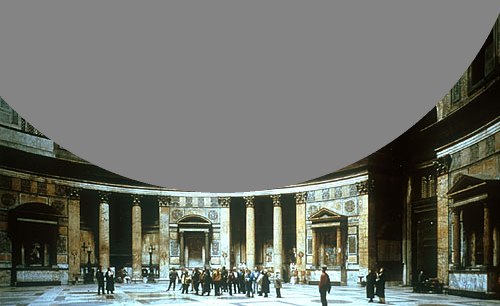
And then there’s the Pantheon, which is built on a 142-foot diameter sphere. As readers of Copernicus, Walter Murch, and BLDGBLOG will know, the Pantheon “may have had secretly encoded within it the idea that the Sun was the center of the universe; and that this ancient, wordless wisdom helped to revolutionize our view of the cosmos.” What better venue for displaying a satellite which indirectly helped revolutionize our view of the origins of the cosmos? And not that it’s necessary, but it even already has a hole in the roof.

Unless I do it outside, Maybe in the Piazza San Marco, where Gregor Schneider’s 46-foot, black, shrouded Venice Cube sculpture was supposed to be installed during the 2005 Biennale. But would a recreation of a relic of American military and media propaganda be any more welcome in Venice than a replica of the Kab’aa? [So I just follow Schneider and install it two years later in the plaza in front of the Hamburg Kunsthalle? I’ll get right on that.]
Or maybe the answer’s right in front of me, and I just don’t want to admit it. Here’s what I wrote last winter about the Sky Walkers parade staged last December by Friends With You [and sponsored by Scion!]
It’s what I’ve always said Art Basel Miami Beach needed more of: blimps.
The only art world venue which can accommodate a 100-foot satelloon is an art fair.
Also of interest: A 1960 Bell Labs film, The Big Bounce, produced by Jerry Fairbanks, tells a very Bell-centric version of the Project Echo story. That horn antenna is something, though. [archive.org, via Lisa Parks’ proposal to integrate satellites into the traditional media studies practice]
The Satelloons Of Project Echo: Must. Find. Satelloons.
From about 1956 until 1964, US aeronautics engineers and rocket scientists at the Langley Research Center developed a series of spherical satellite balloons called, awesomely enough, satelloons. Dubbed Project Echo, the 100-foot diameter aluminumized balloons were one of the inaugural projects for NASA, which was established in 1958.
In his 1995 history of NASA Langley, Space Revolution, Dr. James Hansen wrote:
The Echo balloon was perhaps the most beautiful object ever to be put into space. The big and brilliant sphere had a 31,416-square foot surface of Mylar plastic covered smoothly with a mere 4 pounds of vapor-deposited aluminum. All told, counting 30 pounds of inflating chemicals and two 11-ounce, 3/8-inch-thick radio tracking beacons (packed with 70 solar cells and 5 storage batteries), the sphere weighed only 132 pounds.
For those enamored with its aesthetics, folding the beautiful balloon into its small container for packing into the nose cone of a Thor-Delta rocket was somewhat like folding a large Rembrandt canvas into a tiny square and taking it home from an art sale in one’s wallet.
The satelloons were made from a then-new duPont plastic film called Mylar, which was micro-coated with aluminum using a then-new vacuum vaporizing technique developed by Reynolds Aluminum Co. Originally conceived as research tools to collect data on the density of the upper atmosphere, the reflective satelloons also served as proofs of concept for space-based commmunications systems.
The original research proposal put forward by a Langley engineer named William J. O’Sullivan called for a 20-inch balloon, which was increased to 30 inches. These “Sub Satellites” were followed by a 12-foot diameter Beacon satelloon, the size of which was determined, not by any scientific requirements, but by the ceiling height in the Langley model fabrication room.
In the post-Sputnik euphoria of a 1958 congressional hearing at which a Beacon was inflated in the Capitol Building, O’Sullivan assured politicians that a communications satelloon “10 stories high” could be readied and launched very quickly which could be used “for worldwide radio communications and, eventually, for television, thus creating vast new fields into which the communications and electronics industries could expand to the economic and sociological benefit of mankind.” Such a large, American satellite would also be visible to the naked eyes of everyone in the free world and in the rest of the world. Just like Sputnik, only much, much bigger. It was these 100-foot satellites which were called Echo; the rocket system that would launch these giant balls into space was called Shotput.
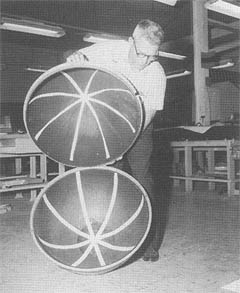
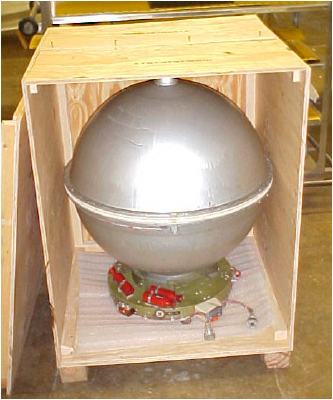
l: nasa. r: flight spare at nasm
With this exponential increase in scale, NASA’s Project Echo team faced major engineering challenges in packing and deploying the satelloon. They eventually devised a two-piece spherical payload container laced together with fishing line and ringed by a small explosive charge, which would deploy the balloon.
Then there was the issue of seams. At a 1959 inflation test in a disused blimp hangar in Weeksville, North Carolina, the original General Mills Echo split apart. A photo in Hansen’s book shows O’Sullivan and his colleagues sticking their heads through a gash of the collapsing balloon. The top photo is from a later 1959 test, also at Weeksville.
Folding was another major challenge. G.T. Schjeldahl, the Minnesota packaging manufacturer contracted to build the Echo satelloons after General Mills, had the adhesive question solved, but they couldn’t figure out how to fold the thing. [Founder Gilmore Schjeldahl is credited with creating the first air sickness bag in 1949. In the 1950’s, his company also made inflatable buildings known as Schjeldomes.]
After watching his wife unfold a tiny plastic rain bonnet, however, Ed Kilgore had a “Eureka moment,” which set Langley’s technicians in motion:
At Langley, Kilgore gave the hat to Austin McHatton, a talented technician in the East Model Shop, who had full-size models of its fold patterns constructed. Kilgore remembers that a “remarkable improvement in folding resulted.” The Project Echo Task Group got workmen to construct a makeshift “clean” room from two by-four wood frames covered with plastic sheeting. In this room, which was 150 feet long and located in the large airplane hangar in the West Area, a small group of Langley technicians practiced folding the balloons for hundreds of hours until they discovered just the right sequence of steps by which to neatly fold and pack the balloon. For the big Echo balloons, this method was proof-tested in the Langley 60-foot vacuum tank as well as in the Shotput flights.
The first Shotput flight occurred almost exactly 48 years ago, in the late afternoon of October 28, 1959. The launch and deployment were successful, but the Beacon exploded, most likely due to residual air left in the balloon to aid its inflation in the vacuum of space. The result was a spectacular, 10-minute light show all along the east coast of the US as “the thousands of fragments of the aluminum-covered balloon…reflected the light of the setting sun.”
To uncover the cause of any future failures, the engineers coated the inside of each satelloon with red fluorescent powder. Then they set up a 500-inch focal length camera on the beach near the launch site to document the unfurling in space. They also publicized the launches well in advance, so they could get mitigate any negative publicity of an explosion–and possibly get some credit for another light show.
Echo 1 was destroyed when its rocket failed. Echo 1A, which was commonly known as Echo 1, was successfully launched August 12, 1960. Bell Labs in Holmdel, New Jersey beamed a radio message from President Eisenhower to it on its first orbit, which was reflected back to the world:
This is President Eisenhower speaking. This is one more significant step in the United States’ program of space research and exploration being carried forward for peaceful purposes. The satellite balloon, which has reflected these words, may be used freely by any nation for similar experiments in its own interest.
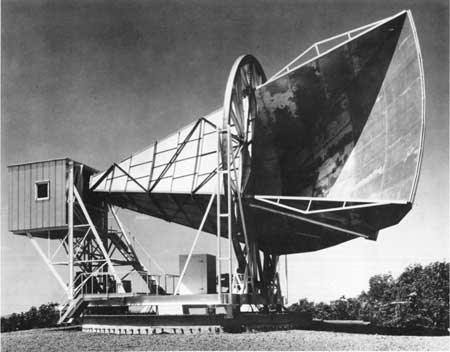
To communicate with the Echo satelloons, Bell Labs built a 50-foot long horn-shaped antenna in Holmdel, which could rotate and pivot on several axes. Later, in 1964, while calibrating the antenna, Drs. Arno Penzias and Robert Wilson detected microwave background radiation, the first concrete evidence of the Big Bang theory. They were awarded the Nobel Prize in 1978.
Echo II was launched in 1964. Both Echo satelloons stayed aloft for years [until 1968 and 1969, respectively] Though not very efficient, their passive communications technology spurred on the development of active signal-transmitting communications satellites like Telstar. An Echo II was exhibited at the 1964 New York World’s Fair, and a folded backup is on display at the National Air & Space Museum.
I’ve highlighted some of the aesthetic or non-scientific elements from Hansen’s long, somewhat rambling but detailed chapter on Program Echo to make a point. Or more accurately, to pose a challenge. In the art world, thanks in no small part to Duchamp, we privilege intentionality above all; anything–even the most mundane or found object, situation, and action–is art if the artist declares it to be so. But nothing else.
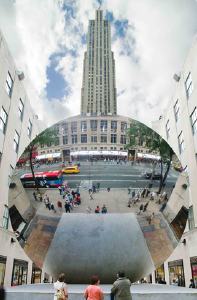
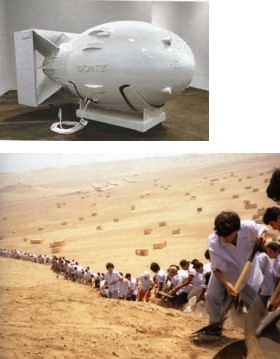
Rirkrit Tiravanija cooking curry; Anish Kapoor employing an engineering firm to build a giant tension-fabric cone or a polished steel parabolic mirror; Michael Heizer etching patterns on the desert with his motorcycle tires; Cai Guo-Qiang exploding an arc of rainbow-colored fireworks across the East River; Tom Sachs replicating Fat Man for Sony; Francis Alys contracting hundreds of laborers to move a mountain of dirt one foot to the left.
How does the remarkable historic, political, cultural, aesthetic, performative, and conceptual achievement of NASA’s Project Echo fit into the cash-and-carry art world? Or, because I’m sure NASA, et al could not care less, and it’s really the art world’s problem, how does the collectively accepted framework of the art world deal with the fantastic, innovative, creative, and life-changing realities of the world around it?
The continent-spanning light show? The largest minimalist sculpture to ever orbit the earth? The hundreds of hours spent folding balloons in a bricoleur’s clean room? The meticulously choreographed performance of folding it? The stop-action artifacts of exploding powder bombs? The emotional and political manipulations of narratives of success and failure, and the rush of collective ego-boosting as a country watches from their porches for Echo to pass overhead?
In practice, product, experience, and impact, Project Echo is every Tate Turbine Hall project, plus half the Turrells [OK, maybe not Roden Crater], plus Happenings, Minimalism, Post-Minimalism, the Wilsons, Sachs, Murakami, Rhoades, Mir, Hayakawa, deMaria, Kapoor, Semmes, Hirshhorn, Hamilton, and more rolled–or should I say folded–into one.
And yet has anyone outside the space stamp collecting community even heard of Echo 1 before Cabinet Magazine published a tiny photo of it in their current issue? I’m an art collector married to a satellite-building NASA astrophysicist, and the whole store party atmosphere of the art fair/biennial circuit’s never felt more like a giant, hermetic NetJets conspiracy than it does right now.
Frankly, I’d rather track down the remaining test models and photos of the Beacon and the Echo. By the time I need a place to install it, hopefully the art world will have caught up/on. Which is a long way of saying I won’t be at Frieze this week.
online: , Ch. 6: The Odyssey of Project Echo, SPACEFLIGHT REVOLUTION by James R. Hansen [history.nasa.gov]
not online: A Minor History of Giant Spheres, by Joshua Foer [cabinetmagazine #27]
The Inflatable Satellite [americanheritage.com]
Previously: Dugway Proving Grounds, the world’s awesomest earth art?
Tape Art And The Eleventh Of September
Wow. Before he became known as Apartment In The Mall Guy, artist Michael Townsend was Tape Art Guy. Over the course of five years, beginning soon after the attack on the World Trade Center, Townsend and his friends created 490 life-sized silhouette portraits of people killed on Sept. 11th using painter’s tape.
Sometimes working with permission, but mostly without, the Tape Art crew installed the portraits across Manhattan in locations that, when viewed on Google Earth, create the outlines of several overlapping hearts emanating from the WTC site. In an article last year for the 5th anniversary of the 9/11 attacks, the Providence Journal called the project, “the world’s first stealth-memorial.”
The are a few execution problems with the project: the heart shapes are a bit too Hallmark-y, and the decision to create portraits only of certain categories of the dead– airplane passengers, police and fire workers–feels like a missed opportunity to universalize the memorial.
One of the most powerful, visceral memorial ideas I ever heard was to place bronze plaques in the form of the “missing” flyers that blanketed the city’s lamp posts and mailboxes and the walls around the 26th St Armory, which served as an early rescue center in the days after the attack. Townsend’s ephemeral, handmade tape portraits dispersed throughout the city get close to the shared sense of loss, and it stands in diametric opposition to the isolated, concentrated, formalized notion of memorializing the dead at a central site.
I wonder how many of these are still around and how long they’ll stay?
Tape Art: The Eleventh of September [tapeart.com]
The Art of Remembrance [projo.com]

